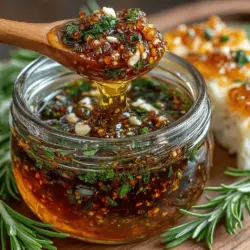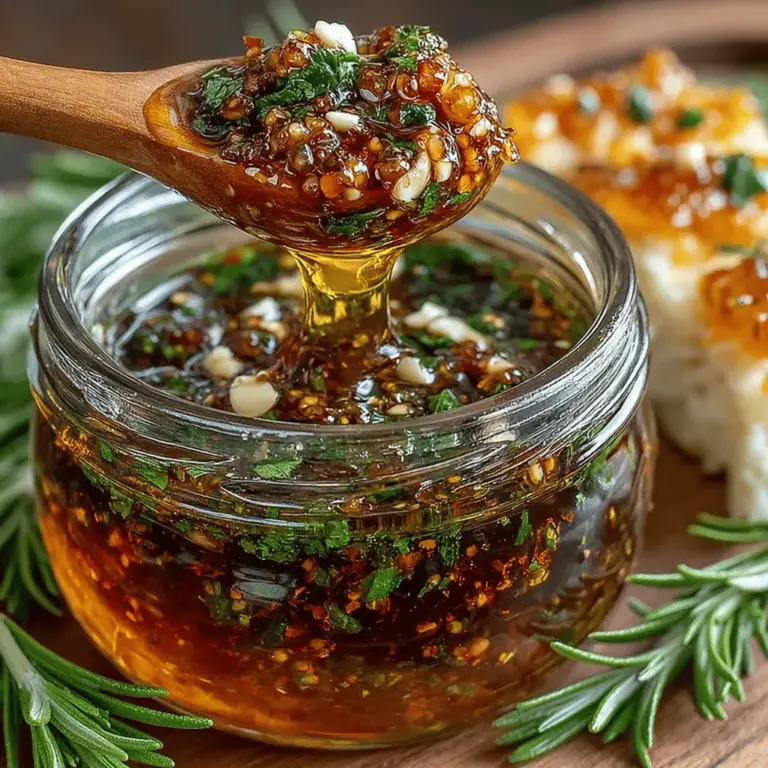Savory Herb-Infused Roasted Balsamic Vinaigrette Recipe
In recent years, there has been a remarkable shift towards homemade dressings, and for a good reason. Not only do they elevate everyday meals, but they also allow for customization that store-bought options simply cannot match. Among the myriad of dressing choices, balsamic vinaigrette stands out for its rich flavor and versatility. This elegant dressing can enhance everything from fresh salads to grilled vegetables and even as a marinade for proteins.
Today, we introduce a delightful twist on the classic balsamic vinaigrette: the Savory Herb-Infused Roasted Balsamic Vinaigrette. This recipe not only brings a depth of flavor through the infusion of herbs and roasted garlic but also offers numerous health benefits thanks to its wholesome ingredients. Whether you’re a culinary novice or a seasoned chef, this vinaigrette is easy to prepare and will undoubtedly elevate your dining experience.
Understanding Balsamic Vinaigrette
To appreciate the richness of balsamic vinaigrette, it’s essential to understand its origins. Balsamic vinegar, renowned for its complex, sweet-tart flavor, hails from Modena, Italy. Traditionally made from the must of freshly crushed grapes, this vinegar undergoes a lengthy aging process in wooden barrels, which contributes to its depth of flavor and syrupy consistency. The quality of balsamic vinegar can vary significantly, so selecting a high-quality version is paramount for achieving the best results in your vinaigrette.
Beyond its flavor profile, balsamic vinegar is packed with nutritional benefits. It is low in calories and contains antioxidants, which can help combat oxidative stress in the body. When combined with extra virgin olive oil, known for its heart-healthy monounsaturated fats and anti-inflammatory properties, this vinaigrette becomes not only a delicious addition to your meals but a health-conscious one as well.
Ingredients Breakdown
Creating a flavorful vinaigrette hinges on the quality of your ingredients. Here’s a closer look at what you will need for the Savory Herb-Infused Roasted Balsamic Vinaigrette:
– Balsamic Vinegar: When selecting balsamic vinegar, you may encounter varying types, such as traditional balsamic vinegar from Modena and commercial-grade varieties. The former offers a richer, more complex flavor, while the latter is often more accessible and affordable. For the best results, opt for a high-quality balsamic vinegar with a dense consistency and a balanced flavor profile.
– Sweeteners: This recipe calls for a sweetener, and you have the option of using honey or maple syrup. Honey adds a floral note and depth, while maple syrup offers a warm caramel flavor. Both sweeteners complement the acidity of balsamic vinegar and help to balance the vinaigrette.
– Extra Virgin Olive Oil: A cornerstone of Mediterranean cuisine, extra virgin olive oil is rich in antioxidants and healthy fats. Its grassy, peppery notes enhance the vinaigrette and help to create a smooth emulsion with the vinegar. When choosing olive oil, look for extra virgin varieties with a robust flavor for the best experience.
– Garlic: Roasting garlic transforms its sharp, pungent flavor into a sweet and mellow essence. This not only enhances the vinaigrette’s flavor but also adds health benefits, as garlic is known for its immune-boosting properties and cardiovascular benefits.
– Dijon Mustard: This ingredient plays a crucial role in emulsifying the vinaigrette, helping to blend the oil and vinegar seamlessly. Additionally, Dijon mustard adds a slight tang and depth of flavor that rounds out the dressing beautifully.
– Herbs: Fresh or dried herbs can elevate your vinaigrette significantly. Fresh herbs offer vibrant flavor and aroma, while dried herbs provide concentrated flavors. Consider using herbs like thyme, oregano, or basil for an aromatic infusion.
– Salt and Pepper: Finally, seasoning with salt and pepper is essential for enhancing all the flavors in your vinaigrette. A pinch of salt can bring out the flavors of the other ingredients, while freshly cracked pepper adds a subtle heat.
Step-by-Step Preparation
Roasting the Garlic
To start, you’ll want to roast the garlic, as this step is critical for flavor development. Roasting mellows the garlic’s harshness, resulting in a sweet, caramelized flavor that enhances the vinaigrette. Here’s how to do it:
1. Preheat your oven to 400°F (200°C).
2. Prepare the garlic: Take a head of garlic and slice off the top to expose the individual cloves. Drizzle a little olive oil over the cut surface and wrap the head in aluminum foil.
3. Roast the garlic: Place the wrapped garlic in the oven and roast for about 30-35 minutes, or until the cloves are soft and golden brown. Once roasted, remove the garlic from the oven and let it cool slightly.
4. Extract the garlic: Squeeze the soft cloves out of their skins and set them aside.
With the garlic roasted to perfection, you can now move on to preparing the vinaigrette base, which will combine all these delightful ingredients into a harmonious dressing.
Stay tuned for the following steps where we will guide you through combining the ingredients and achieving the ideal consistency and flavor profile for your Savory Herb-Infused Roasted Balsamic Vinaigrette.

Techniques for Whisking Balsamic Vinegar with Honey/Maple Syrup and Mustard for Optimal Blending
Creating a delicious vinaigrette requires a bit of technique, especially when it comes to blending the core ingredients. Start by combining balsamic vinegar with your choice of sweetener, either honey or maple syrup, along with a spoonful of Dijon mustard. The mustard not only adds flavor but also acts as an emulsifier, which helps to bind the oil and vinegar together.
To achieve optimal blending, use a whisk for this process. Begin by whisking the balsamic vinegar, honey or maple syrup, and mustard together in a mixing bowl. The key is to whisk vigorously until the mixture is well-combined and begins to thicken slightly. This action helps to dissolve the sweetener fully and disperse the mustard evenly throughout the mixture, creating a cohesive base for your vinaigrette.
Incorporating Olive Oil
Explanation of Emulsification
Emulsification is the process of combining two liquids that usually don’t mix well, like oil and vinegar. For vinaigrettes, achieving a stable emulsion is crucial to getting that silky texture we all love. Once you’ve whisked your balsamic mixture, it’s time to slowly incorporate the olive oil.
Begin adding the olive oil in a slow, steady stream while continuously whisking. This method ensures that the oil integrates smoothly into the vinegar mixture, rather than floating on top. The vigorous mixing creates tiny droplets of oil suspended in the vinegar, resulting in a well-emulsified vinaigrette that is both smooth and creamy.
Adding Herbs and Seasoning
The Significance of Timing in Adding Roasted Garlic and Herbs
When it comes to infusing flavors into your vinaigrette, timing is everything. If you’re using roasted garlic, add it to the vinaigrette after you have achieved a stable emulsion. Roasted garlic adds a mellow sweetness and depth of flavor, enhancing the overall profile of the vinaigrette. Simply mash the roasted garlic into a paste and whisk it into the vinaigrette after the oil has been fully incorporated.
As for the herbs, whether you are using fresh or dried herbs, it’s essential to consider when you add them. Fresh herbs, like basil or parsley, should be added at the end of the mixing process to preserve their vibrant color and flavor. Dried herbs, on the other hand, can be added earlier in the process, allowing their flavors to meld into the vinaigrette as it sits.
How to Adjust Flavors and Achieve the Perfect Balance
Taste your vinaigrette as you go along. If it’s too acidic, add a touch more honey or maple syrup to balance the flavors. If it lacks depth, consider adding more mustard or a pinch of salt to enhance the overall taste. The goal is to achieve a harmonious balance between the tang of the balsamic vinegar, the sweetness from the honey/maple syrup, and the rich flavor of the olive oil.
Mixing and Storing
Recommendations for Storage to Maintain Freshness and Flavor
To keep your Savory Herb-Infused Roasted Balsamic Vinaigrette fresh, store it in an airtight container in the refrigerator. It’s best to use it within a week or two for optimal flavor. As with many homemade dressings, the flavors will deepen and improve as it sits, so don’t hesitate to make it a day in advance.
How to Properly Shake and Serve the Vinaigrette
Before serving, give the vinaigrette a good shake or whisk to recombine any separated ingredients. Homemade vinaigrettes tend to separate over time, so a quick mix will ensure that every ingredient is evenly distributed. Drizzle over your favorite salads, roasted vegetables, or grilled meats, and enjoy the burst of flavor!
Serving Suggestions
Creative Ways to Use the Vinaigrette
This Savory Herb-Infused Roasted Balsamic Vinaigrette is incredibly versatile. Use it as a salad dressing for a variety of greens, from simple mixed greens to more complex salads featuring fruits and nuts. It perfectly complements the earthiness of roasted vegetables, making it an excellent choice for drizzling over dishes like roasted carrots, Brussels sprouts, or squash.
For those who enjoy grilling, this vinaigrette works wonderfully as a marinade for proteins such as chicken, fish, or tofu. Simply marinate your chosen protein for at least 30 minutes before cooking to infuse it with flavor. Additionally, consider pairing the vinaigrette with cheeses or crusty bread for an elegant appetizer or snack.
Health Benefits of Homemade Vinaigrette
Comparison of Homemade Versus Store-Bought Dressings
One of the significant advantages of making your own vinaigrette is the control you have over the ingredients. Many store-bought dressings are filled with preservatives, artificial flavors, and added sugars. By making your vinaigrette at home, you can ensure that you’re using high-quality ingredients without any hidden additives.
Benefits of Controlling Ingredients for Health-Conscious Individuals
For health-conscious individuals, homemade vinaigrettes allow for customization to suit dietary needs. You can easily adjust the sweetness, saltiness, or acidity according to your preferences or restrictions. Using natural sweeteners like honey or maple syrup instead of refined sugars also boosts the nutritional profile of your dressing.
The Role of Healthy Fats and Natural Sweeteners in Nutrition
Olive oil is rich in monounsaturated fats, which are beneficial for heart health. Additionally, the antioxidants found in balsamic vinegar can help reduce inflammation. The natural sweeteners used in this vinaigrette provide a healthier alternative to processed sugars, contributing to a balanced diet.
Conclusion
Creating a Savory Herb-Infused Roasted Balsamic Vinaigrette is a simple yet rewarding culinary endeavor. This versatile dressing not only elevates your salads and dishes but also promotes a healthier lifestyle through its wholesome ingredients. The ability to customize flavors and experiment with various herbs and seasonings means you can make this vinaigrette truly your own.
By taking the time to make your dressings at home, you are enhancing your meals with fresh flavors and nutritional benefits. We encourage you to explore different variations of this recipe, adding your favorite herbs or spices, and discover how easy it is to bring gourmet tastes to your dining table. Enjoy the process of creating a vinaigrette that suits your taste and enhances every meal!

